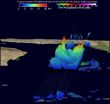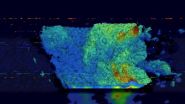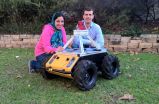NASA sees powerful storms within Tropical Cyclone Ashobaa
2015-06-10
(Press-News.org) wo NASA satellites provided a look inside and outside of Tropical Cyclone Ashobaa. NASA and JAXA's GPM satellite observed rainfall rates and cloud heights identifying powerful thunderstorms within the cyclone, and NASA's Aqua satellite provided an overall look at Ashobaa's cloud extent.
The Global Precipitation Measurement (GPM) core observatory had an excellent view of Tropical Cyclone Ashobaa in the Arabian Sea over on June 8, 2015 at 2131 UTC (5:31 p.m. EDT). As expected, Tropical Cyclone Ashobaa was more powerful than when seen by GPM earlier in the day. GPM's Microwave Imager (GMI) and Dual-Frequency Precipitation Radar (DPR) instruments showed that rain was falling at a rate of over 70.5 mm (about 2.8 inches) per hour in bands of storms west of the center of circulation.
Very powerful storms were seen west of tropical cyclone ASHOBAA's center of circulation by GPM's Ku Band Radar. A 3-D view constructed from GPM's Ku band radar data shows that Tropical Cyclone Ashobaa had some extremely tall storms. GPM radar data indicated that some of these very intense storms were reaching the amazing height of 21 km (13 miles).
On June 10 at 09:00 UTC (5 a.m. EDT), the Moderate Resolution Imaging Spectroradiometer or MODIS instrument aboard NASA's Aqua satellite captured a visible image of Tropical Cyclone Ashobaa off the coast of Oman. There was no visible eye in the system, although it appears to be strengthening. Bands of thunderstorms were spiraling into the low-level center from the west and east. The MODIS image showed that the northwestern quadrant of the tropical storm was already sweeping over eastern Oman.
The Joint Typhoon Warning Center (JTWC) noted that "Animated multispectral satellite imagery depicts tight spiral banding wrapping beneath a central dense overcast feature that is elongated to the west due to moderate (15-20 knot) easterly vertical wind shear that will persist throughout the forecast period." Microwave imagery shows disorganized convection along the western edge of the storm, while an eye feature can be seen in microwave data.
By 1500 UTC (11 a.m. EDT), Ashobaa's maximum sustained winds had increased to 55 knots (63.9 mph/ 101.9 kph). Ashobaa was centered near 20.9 North latitude and 61.0 east longitude, about 138 nautical miles (158.8 miles/255.6 km) east-northeast of Masirah Island, Oman. The tropical storm is slowly moving west at 3 knots (3.4 mph/5.5 kph).
The JTWC now expects that Ashobaa will not reach hurricane-strength before making landfall early on June 12 and will weaken quickly thereafter between the interaction with land and dry air that is forecast to move into the circulation.
INFORMATION:
ELSE PRESS RELEASES FROM THIS DATE:
2015-06-10
Genetically modified fish that overexpress growth hormone have been created for more than 25 years, but unlike many domesticated crops, transgenic fish have yet to enter commercial production. Because of the difficulty inherent in eradicating an established fish population, efforts are under way to model the threat posed by possible invasions.
In an article for an upcoming issue of BioScience, a team of government and academic researchers, led by Robert Devlin of Fisheries and Oceans Canada, examined the possible outcomes of an accidental release of transgenic fish. Their ...
2015-06-10
The air around us is a chaotic superhighway of molecules whizzing through space and constantly colliding with each other at speeds of hundreds of miles per hour. Such erratic molecular behavior is normal at ambient temperatures.
But scientists have long suspected that if temperatures were to plunge to near absolute zero, molecules would come to a screeching halt, ceasing their individual chaotic motion and behaving as one collective body. This more orderly molecular behavior would begin to form very strange, exotic states of matter -- states that have never been observed ...
2015-06-10
Most galaxies are clumped together in groups or clusters. A neighboring galaxy is never far away. But this galaxy, known as NGC 6503, has found itself in a lonely position, at the edge of a strangely empty patch of space called the Local Void.
The Local Void is a huge stretch of space that is at least 150 million light-years across. It seems completely empty of stars or galaxies. The galaxy's odd location on the edge of this never-land led stargazer Stephen James O'Meara to dub it the "Lost-In-Space galaxy" in his 2007 book, Hidden Treasures.
NGC 6503 is 18 million ...
2015-06-10
New research from UBC and the Child & Family Research Institute at BC Children's Hospital shows that risky outdoor play is not only good for children's health but also encourages creativity, social skills and resilience.
The findings, published in the International Journal of Environmental Research and Public Health, found that children who participated in physical activity such as climbing and jumping, rough and tumble play and exploring alone, displayed greater physical and social health.
"We found that play environments where children could take risks promoted increased ...
2015-06-10
Google searches for information on melanoma and skin cancer increased over the summer months during a five-year period, although the level of interest did not correlate with the melanoma mortality to incidence ratio, suggesting that increased search volumes may not be associated with early detection, according to a research letter published online by JAMA Dermatology.
Researcher Kyle T. Amber, M.D., of MacNeal Hospital, Berwyn, Ill., and coauthors used Google Trends, a research tool which quantifies interest in topics at the population level by analyzing all search queries ...
2015-06-10
For years, research on nuclear weapons has relied on old data, limited experiments and computer modeling. But this year, that pattern has changed. Scientists have run new experiments that simulate what happens to plutonium in a nuclear explosion, according to an article in Chemical & Engineering News (C&EN), the weekly newsmagazine of the American Chemical Society. The research will deepen scientists' understanding of the element -- and help them analyze a nuclear event should one occur.
In the article, Jyllian Kemsley, a senior editor at C&EN, notes that six years ago, ...
2015-06-10
Using the intestinal hormone GLP-1 in obesity treatment prevents the loss of bone mass otherwise frequently associated with major weight loss. This is the finding of a new study from the University of Copenhagen, Hvidovre and Glostrup Hospital. According to the researchers behind the study, the results may have a significant bearing on future obesity treatment.
Rapid weight loss leads to a loss of bone mass and an increased risk of bone fractures. New research shows that treating obesity with the GLP-1 hormone helps prevent loss of bone mass in addition to having a number ...
2015-06-10
June 10, 2015--Low-income families bear the brunt of high-energy costs and poor thermal comfort from poorly maintained apartment buildings. To study how energy efficiency upgrades could help these households, researchers at Columbia University's Mailman School of Public Health surveyed residents in a low-income community in New York City. They found that while energy efficiency upgrades varied significantly by ownership status, low-income single-family homeowners reaped the greatest direct benefits. Results overall showed that respondents experienced improved thermal comfort, ...
2015-06-10
WASHINGTON - While a 1980 reform law enabled the modernization and stabilization of the U.S. freight railroad industry, federal regulation has not kept pace with the industry's transformation and should be replaced with a system better-suited for today's freight rail system, says a new congressionally mandated report from the National Research Council's Transportation Research Board. Current policies designed to protect rail shippers who lack transportation options from excessive rates are not working for shippers of most commodities, including grain. More appropriate, ...
2015-06-10
The way insects see and track their prey is being applied to a new robot under development at the University of Adelaide, in the hopes of improving robot visual systems.
The project - which crosses the boundaries of neuroscience, mechanical engineering and computer science - builds on years of research into insect vision at the University.
In a new paper published today in the Journal of The Royal Society Interface, researchers describe how the learnings from both insects and humans can be applied in a model virtual reality simulation, enabling an artificial intelligence ...
LAST 30 PRESS RELEASES:
[Press-News.org] NASA sees powerful storms within Tropical Cyclone Ashobaa




